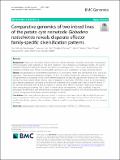Files in this item
Comparative genomics of two inbred lines of the potato cyst nematode Globodera rostochiensis reveals disparate effector family-specific diversification patterns
Item metadata
| dc.contributor.author | van Steenbrugge, Joris J.M. | |
| dc.contributor.author | van den Elsen, Sven | |
| dc.contributor.author | Holterman, Martijn | |
| dc.contributor.author | Sterken, Mark G. | |
| dc.contributor.author | Thorpe, Peter | |
| dc.contributor.author | Goverse, Aska | |
| dc.contributor.author | Smant, Geert | |
| dc.contributor.author | Helder, Johannes | |
| dc.date.accessioned | 2021-08-12T10:30:08Z | |
| dc.date.available | 2021-08-12T10:30:08Z | |
| dc.date.issued | 2021-08-11 | |
| dc.identifier | 275433078 | |
| dc.identifier | d8d050de-5aa2-4351-80eb-2835487ef543 | |
| dc.identifier | 000684208100001 | |
| dc.identifier | 85112304764 | |
| dc.identifier.citation | van Steenbrugge , J J M , van den Elsen , S , Holterman , M , Sterken , M G , Thorpe , P , Goverse , A , Smant , G & Helder , J 2021 , ' Comparative genomics of two inbred lines of the potato cyst nematode Globodera rostochiensis reveals disparate effector family-specific diversification patterns ' , BMC Genomics , vol. 22 , 611 . https://doi.org/10.1186/s12864-021-07914-6 | en |
| dc.identifier.issn | 1471-2164 | |
| dc.identifier.other | RIS: urn:4D8CFFD6D2E145DC01D720278EE94741 | |
| dc.identifier.other | RIS: van Steenbrugge2021 | |
| dc.identifier.uri | https://hdl.handle.net/10023/23766 | |
| dc.description | This work was funded as part of a grant by the Netherlands Organization for Scientific Research (NWO) as part of the Applied and Technical Science domain (TTW) under grant no. 14708. PT: bioinformatics and computational biology analyses were supported by the University of St Andrews Bioinformatics Unit (AMD3BIOINF), funded by Wellcome Trust ISSF award 105621/Z/14/Z. | en |
| dc.description.abstract | Background: Potato cyst nematodes belong to the most harmful pathogens in potato, and durable management of these parasites largely depends on host-plant resistances. These resistances are pathotype specific. The current Globodera rostochiensis pathotype scheme that defines five pathotypes (Ro1 - Ro5) is both fundamentally and practically of limited value. Hence, resistant potato varieties are used worldwide in a poorly informed manner. Results : We generated two novel reference genomes of G. rostochiensis inbred lines derived from a Ro1 and a Ro5 population. These genome sequences comprise 173 and 189 scaffolds respectively, marking a ≈ 24-fold reduction in fragmentation as compared to the current reference genome. We provide copy number variations for 19 effector families. Four dorsal gland effector families were investigated in more detail. SPRYSECs, known to be implicated in plant defence suppression, constitute by far the most diversified family studied herein with 60 and 99 variants in Ro1 and Ro5 distributed over 18 and 26 scaffolds. In contrast, CLEs, effectors involved in feeding site induction, show strong physical clustering. The 10 and 16 variants cluster on respectively 2 and 1 scaffolds. Given that pathotypes are defined by their effectoromes, we pinpoint the disparate nature of the contributing effector families in terms of sequence diversification and loss and gain of variants. Conclusions : Two novel reference genomes allow for nearly complete inventories of effector diversification and physical organisation within and between pathotypes. Combined with insights we provide on effector family-specific diversification patterns, this constitutes a basis for an effectorome-based virulence scheme for this notorious pathogen. | |
| dc.format.extent | 19 | |
| dc.format.extent | 2232577 | |
| dc.language.iso | eng | |
| dc.relation.ispartof | BMC Genomics | en |
| dc.subject | Heterozygosity | en |
| dc.subject | Gland proteins | en |
| dc.subject | Innate immune system | en |
| dc.subject | SPRYSEC | en |
| dc.subject | CLE | en |
| dc.subject | Effectoromics | en |
| dc.subject | QH426 Genetics | en |
| dc.subject | QR Microbiology | en |
| dc.subject | 3rd-DAS | en |
| dc.subject.lcc | QH426 | en |
| dc.subject.lcc | QR | en |
| dc.title | Comparative genomics of two inbred lines of the potato cyst nematode Globodera rostochiensis reveals disparate effector family-specific diversification patterns | en |
| dc.type | Journal article | en |
| dc.contributor.sponsor | The Wellcome Trust | en |
| dc.contributor.institution | University of St Andrews. School of Medicine | en |
| dc.contributor.institution | University of St Andrews. St Andrews Bioinformatics Unit | en |
| dc.identifier.doi | 10.1186/s12864-021-07914-6 | |
| dc.description.status | Peer reviewed | en |
| dc.identifier.grantnumber | en |
This item appears in the following Collection(s)
Items in the St Andrews Research Repository are protected by copyright, with all rights reserved, unless otherwise indicated.

